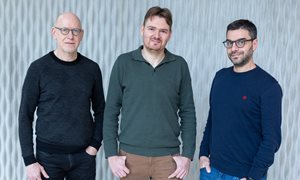
The incidence of stroke is increasing worldwide, both in the Western world and in low-to-middle income countries. Environmental factors and an unhealthy lifestyle are significant contributors. Although treatment methods have expanded in recent years, it remains essential to initiate treatment for stroke as quickly as possible. Physicians from Radboud university medical center highlight this in a review article in The Lancet.
Stroke is an umbrella term for ischemic strokes and intracerebral hemorrhages. For both types, prompt and appropriate action is crucial for a favorable outcome, as emphasized by the doctors from Radboudumc. In a review published in the scientific journal The Lancet, they describe the major developments in ischemic stroke, which occurs when a vessel supplying blood to the brain is obstructed, and in intracerebral hemorrhage, a sudden bleeding into brain tissue due to a ruptured blood vessel.
90% can be prevented
Ninety percent of all strokes are preventable, according to the last author and professor of Neurology Frank Erik de Leeuw of Radboudumc: ‘It is a disease of affluence. We know a significant number of risk factors, but we fail to identify or address them in time. That's frustrating.’ These factors include high blood pressure and diabetes, as well as an unhealthy lifestyle. Smoking, obesity, lack of exercise, and an unhealthy, high-salt diet increase the risk of ischemic stroke or intracerebral hemorrhage. Recreational drug use may also play a role in the increasing number of strokes among young people. More research into this is needed.
In addition to individual factors, environmental factors also increase the risk, such as air pollution from traffic and wood stoves, which predominantly heat homes in low-to-middle income countries (LMIC’s). De Leeuw explains, ‘We see a stronger increase in the number of strokes there than in high-income countries.’ Besides these environmental factors, the recent increase in prosperity in those countries, including an unhealthier lifestyle, also contributes. Moreover, healthcare in these countries is less well organized than in the West. ‘Where we have good access to healthcare providers, many people in African countries probably don't know they have diabetes or high blood pressure. And if they do know, medication may not always be available, or the distances to healthcare are too great.’
The sooner the better
This underscores the importance of immediate care, De Leeuw emphasizes, as nearby care enables swift treatment. Although recent studies show that acute treatment of ischemic stroke can also begin within 24 hours of symptom onset, the adage ‘The sooner the better’ still holds true.
TIA is an ischemic stroke
Prompt action is also essential for a transient ischemic attack (TIA). ‘A TIA is just an ischemic stroke, albeit short-lived. Therefore, it should be treated as such,’ says De Leeuw. ‘So don't wait a few days if you have symptoms. The risk of a new stroke is greatest/highest in those first few days.’ Again, the earlier the treatment begins, the better the outcome. Raising awareness is crucial, according to De Leeuw: ‘People shouldn't take it lightly.’
Intracerebral hemorrhage
A intracerebral hemorrhage is the most severe form of stroke, with four out of ten patients dying within a month. Currently, a large study is underway to investigate the treatment of intracerebral hemorrhages, led by Nijmegen-based neurology professor Karin Klijn. Along with colleagues from various hospitals, she is studying a new treatment method in which a large part of the bleeding is surgically removed through a minimally invasive procedure. This operation must take place quickly, within eight hours of the bleed, and may increase the chances of a good recovery.
Imaging
An important change in recent years concerns how patients are selected for acute ischemic stroke treatment. In recent years, imaging of brain perfusion has played a significant role in this, says lead author and neurology resident Nina Hilkens. ‘The most recent trials show that a routine CT scan combined with imaging of the blood vessels and any occlusions therein often suffices. This technique is easier to implement in LMIC’s.’
The future
Preventing stroke is preferable, as once people have experienced an ischemic stroke, they are at increased risk of another one. Neurologists and researchers want to prevent this as well. Hilkens says, ‘This is called secondary prevention. After an ischemic stroke, people take antithrombotics; medications that prevent new clots from forming in blood vessels. However, these medications come with side effects and new risks, including an increased risk of bleeding.’
Therefore, Hilkens and De Leeuw are starting a study to investigate whether it is necessary for people who experience an ischemic stroke at a young age without any known cause to use platelet inhibitors for life. For these young patients, aged between 18 and 49, it has never been studied whether there are benefits to lifelong use of platelet inhibitors and whether these benefits outweigh the drawbacks.
Stroke: recognize the signs
Stroke affects up to one in five people in some high-income countries and nearly one in two in low-income countries. It is the second leading cause of death worldwide. In the Netherlands, approximately 30,000 people have an ischemic stroke and over 50,000 people experience a TIA annually. 6000 people suffer from a intracerebral hemorrhage. Signs that may indicate a stroke include a drooping mouth, slurred speech, and sudden weakness or paralysis of an arm.
About the publication
This review appeared in The Lancet: Stroke – Nina A Hilkens, Barbara Casolla, Thomas W Leung, Frank-Erik de Leeuw. DOI: https://doi.org/10.1016/S0140-6736(24)00642-1.
-
Want to know more about these subjects? Click on the buttons below for more news.
More information
Pauline Dekhuijzen

wetenschaps- en persvoorlichter






